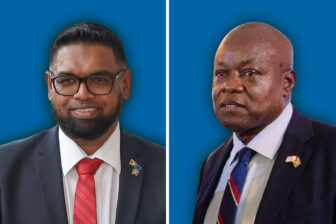In the September 1 general elections, Guyanese citizens voted for president, vice president, and all 65 seats in the National Assembly. Official results are pending, but preliminary tallies indicate that President Irfaan Ali has won reelection by a wide margin and that his ruling party, the People’s Progressive Party/Civic (PPP/C), will hold onto its majority in the legislature.
The count also shows that the country’s other traditionally strong coalition, A Partnership for National Unity (APNU), has been surpassed by a newcomer: We Invest in Nationhood (WIN). Now the country’s main opposition party, WIN was founded three months ago by controversial outsider candidate Azruddin Mohamed, a wealthy businessman sanctioned by the U.S. for alleged tax evasion on gold exports.
At stake is oversight of the country’s oil boom, which continues to gain momentum. Guyana’s GDP grew 43.6% in 2024, and the IMF projects a 10.3% expansion in 2025. In the election, the population of around 800,000 weighed the best choice to ensure the gains are appropriately distributed. The poverty rate remains high, around 58%, and health outcomes still lag behind regional and peer-country averages, according to the World Bank.
AQ asked analysts to share their reactions.

Carl Greenidge
Former vice president, foreign secretary and foreign affairs minister in former President David Granger’s APNU administration
Election turnout was quite low, estimated at 50%. This hurt all established parties except the governing PPP/C. The APNU/PNC opposition alliance suffered a catastrophic decline in vote share and has been displaced by the new WIN party as the country’s primary opposition group.
While the PPP/C retained its strongholds and increased its take, the APNU/PNC failed to win any of the country’s 10 regions for the first time in its history, including in its traditional strongholds of Georgetown and Regions 1, 4 and 10. This outcome, especially in the APNU’s strongholds, is statistically improbable and has raised concerns of tampering among some observers. This is why there are disputes over numbers and recounts.
If the current results hold, the PPP/C will boast a record 36 seats in the 65-member National Assembly, while APNU will go from 31 to just 12. Meanwhile, dark horse candidate Azruddin Mohamed and his WIN party rose rapidly to national prominence, despite Mohamed’s rumored background in allegedly smuggling gold and other activities that precipitated U.S. sanctions.
The WIN party’s momentum was fueled in recent weeks by heavy-handed efforts by the PPP/C government to shut down Mohamed’s campaign and block his access to the banking system. This, along with the U.S. ambassador’s intervention, won Mohamed’s party considerable sympathy among the public, as did Mohamed’s “charity” campaigns ahead of the elections that were criticized as vote-buying. In fact, he faces allegations of vote-buying on a scale never before seen in Guyana.
The opposition as a whole will now face several key challenges. First, how will they deal with each other and the PPP/C in the face of PPP/C attempts to coopt them? Second, sensitive constitutional and governance issues remain pending, most of which require consultation with the new Leader of the Opposition, most likely Mohamed himself.
Meanwhile, for the first time in Guyana’s history, its two prinicipal political parties will be led by members of the small Muslim minority, estimated at under 10% of the population. Critics say PPP/C-led governments have worsened economic exclusion and discrimination of the Afro-Guyanese population, something the APNU has long advocated against. A weakened APNU could mean less accountability on this issue.
The APNU and its leader, Aubrey C. Norton, are likely to see continued internal dissent and defections. Norton will have to choose just 12 MPs to serve in the Assembly from a large pool, even as he tries to balance the competing expectations of the various parties within his coalition and other allies.
Finally, Guyana’s government, however composed, faces immediate threats from Venezuela. Mohamed is something of a wildcard on this front, as he has been accused by Guyanese authorities of having back-door communication with Maduro’s government. Venezuela’s saber-rattling poses a real menace to the stability and even the continued existence of Guyana, especially considering Venezuela’s alliances with powerful enemies of the current international order and the global context of trouble for other small states.

Francisco Monaldi
Director of the Latin America Energy Program at the Center for Energy Studies at Rice University’s Baker Institute for Public Policy
As expected, President Ali and his party, the PPP/C, were reelected with a wider majority than the razor-thin margin they attained in 2020. Guyana’s world-record GDP growth, driven by the oil production boom, made it hard to dislodge the party in power. Guyana has become the largest per capita oil producer in the world, only six years after oil production began. So far, the country has managed to avoid the major pitfalls of resource booms. The government has (largely) respected legal and contractual frameworks and saved a relevant portion of the fiscal revenues in the Natural Resources Fund (even though there was a concerning spending spree during the electoral cycle). Although facing delays, the government has focused infrastructure projects on the right priorities: transportation and electrification.
However, there are clouds on the horizon. The electoral over-performance of populist businessman Azruddin Mohamed, who is sanctioned by the U.S. and promised to renegotiate the contract with Exxon, could signal potential political and economic instability down the road. The collapse of the opposition PNC, the traditionally Afro-Guyanese-supported party, could lead that segment of the population to feel disenfranchised from the benefits of the oil boom.
Resource booms are not an inevitable curse, but prudent oil wealth management is quite challenging. As fiscal revenues multiply by four in the next five years, pressures to increase consumption, rather than saving or investing, will creep up, risking macroeconomic destabilization and political upheaval. In the context of an ethnically divided country with young and fragile institutions, this could derail the promise of sustainable economic development.

Shreiner Parker
Head of emerging markets at Rystad Energy
Early indicators suggest President Irfaan Ali is poised to secure a second five-year term, reinforcing the People’s Progressive Party/Civic’s (PPP/C) control amid Guyana’s booming oil economy. His vice president, Bharrat Jagdeo, an experienced former president often likened to a Dick Cheney figure, continues to exert considerable influence behind the scenes, ensuring stability in governance as Guyana’s oil production scales toward the 2050s.
This election stood out for what wasn’t at issue: There were no calls to renegotiate ExxonMobil’s Stabroek Block contract. The French adage, “The fate of glass is to break” aptly describes the eventual destiny of the Stabroek license. But that moment lies well beyond this term, and certainly beyond the Ali administration. With so much of the resource base still unfinalized, maintaining contract sanctity is prudent. Interrupting that framework now could jeopardize investor confidence, delay multi-billion-dollar developments, and ultimately diminish future government revenues.
Looking decades ahead, however, Guyana’s prolific oil potential, expected to stretch well into the 2050s, almost guarantees the Stabroek contract will one day be reconsidered. Generational shifts, economic evolution, and governance demand will all influence when and how that occurs. Today’s outcome grants the country a window, a period of calm and continuity, in which institutions and infrastructure can be strengthened as the oil economy matures.
Opposition groups, including the newcomer WIN party led by Azruddin Mohamed, remain longshots and unlikely to disrupt the PPP/C’s dominance. Instead, the enduring, ethnically polarized structure of Guyanese politics is more likely to determine how future debates over oil governance play out.
For now, investors can take confidence in a steady path forward—the government remains focused on delivering results. But the knowledge that the glass must one day break adds a vital perspective: Guyana’s oil story is not just about the immediate boom. It’s a multi-decade saga, one in which contracts, politics, and national strategy will evolve together.

Desmond Thomas
Economist and the coordinator of the Electoral Reform Group in Guyana
Guyana’s anxiously awaited general election has been concluded—incident-free by all accounts—and now begins the period of waiting for the final results. Two conditions fuel the expectations of this election. Firstly, this election marks the completion of the first term of government in the oil era—when the oil companies have ramped up production to almost one million barrels a day, causing the country to experience astronomical growth rates of GDP. Secondly, the political crisis following the 2020 election that took five months before the new government could take office remains fresh in people’s minds. This combination of circumstances has raised the stakes on state power and caused some anxiety. Although election-day management appears to have proceeded smoothly and competently, the large-scale use of the governing party’s position of incumbency undermines confidence in there being a level playing field.
It will take a day or two before the election results are finalized. Speculation is risky—even for an election observer who has visited half a dozen polling places. However, a few impressions are emerging. Six parties contested the election: The People’s Progressive Party/Civic, A Partnership for National Unity (APNU), We Invest In Nationhood (WIN) the Alliance for Change (AFC) which participated in the 2015-2020 Government as a coalition partner of A Partnership for National Unity (APNU), the Assembly of Liberty and Prosperity (ALP) and Forward Guyana Movement (FGM). The ALP and FGM were recently formed by persons defecting from APNU. Out of the six parties it appears to have turned into a three-horse race. The traditional rivals, the incumbent PPP/C and the Opposition APNU are joined by WIN (We Invest in Nationhood) under the controversial leadership of Azruddin Mohammed who faces U.S. sanctions, accused of tax evasion for large quantities of gold exports.
The meteoric rise in WIN’s popularity is a conspicuous factor in this election. It remains to be seen what kind of difference it will make. It will not be known for sure until all the tabulations are in, but preliminary observations suggest a lower than usual turnout. Casual observation also suggest a low turnout among youths along the East Bank, Demerara corridor. The main takeaway from these observations is the existence of a strong groundswell of dissatisfaction with developments in the new oil economy. People want change in the political status quo and the way the country is managed. One hopes that whatever the election outcome, political leaders get the message that it cannot be business as usual.








